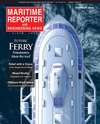
Page 15: of Maritime Reporter Magazine (February 2019)
Ferry Builders
Read this page in Pdf, Flash or Html5 edition of February 2019 Maritime Reporter Magazine
I
INSIGHTS: FERRY BUSINESS
Last summer we lobbied in favor of the gen from renewable sources. 34 new members to the association, in- strength from unity will ensure that the bespoke approach after France proposed The initiative amply demonstrates In- cluding a surge from Central and South ferry industry remains supremely pro- screening all ferry passengers on vehicle terferry’s belief in a ‘Stronger Together’ America thanks to our Cancun con- gressive when facing the challenges and decks. Alarmed at the potential for ac- work ethic. Last year we welcomed ference venue. Sharing our vision of opportunities that lie ahead. cident or terrorist action in confned spaces, Interferry helped to persuade a rethink allowing local authorities and individual ferry companies to determine measures based on a terminal-by-termi- nal risk assessment.
More recently the committee has been looking at stowaway issues, a particular problem in the Mediterranean region.
Interferry has also engaged with the CSO
Alliance of maritime company security ofcers – a support network of some 700 members in more than 40 countries – regarding a cyberattack initiative and plans for a dedicated partnership linking ferry ports and operators.
Last but far from least, the infuence of our Regulatory Committee has had a truly astounding impact in protecting the viability of the ferry industry. Much of this work derives from government and maritime authority proposals on en- vironmental protection, where the main focus is on reducing emissions. Inter- ferry utterly supports the drive towards a greener planet, but equally we argue that any measures must take account of the sector-specifc design and operational requirements of ferries.
Last year, the IMO accepted our case for a critical 20% correction to the En- ergy Efciency Design Index calculation formula for RoPax and RoRo vessels.
Our ‘one size does not ft all’ lobbying also won confrmation that, in contrast to tightened requirement for some other ship types, the original improvement tar- gets – set at 10% by 2015, 20% by 2020 and 30% by 2025 – would remain in force for ferries.
We respect the IMO’s aim to halve shipping’s absolute carbon footprint by 2050, but relevant interventions remain a priority. Moves to mandate speed re- ductions are a current concern, because slow steaming is less feasible for short- sea timetables as opposed to deepsea schedules. Meanwhile the quest to re- duce shipping emissions largely centers on adopting alternatives to heavy diesel fuel. Ferry operators are showing the way with solutions ranging from low- sulfur diesel to LNG, electrifcation and hybrid technology. Looking further ahead, Interferry itself is part of the six- nation, European Union-backed hyseas
III project launched last summer to de- velop the world’s frst seagoing, zero emissions ro-ro ferry powered by hydro- www.marinelink.com 15

 14
14

 16
16
